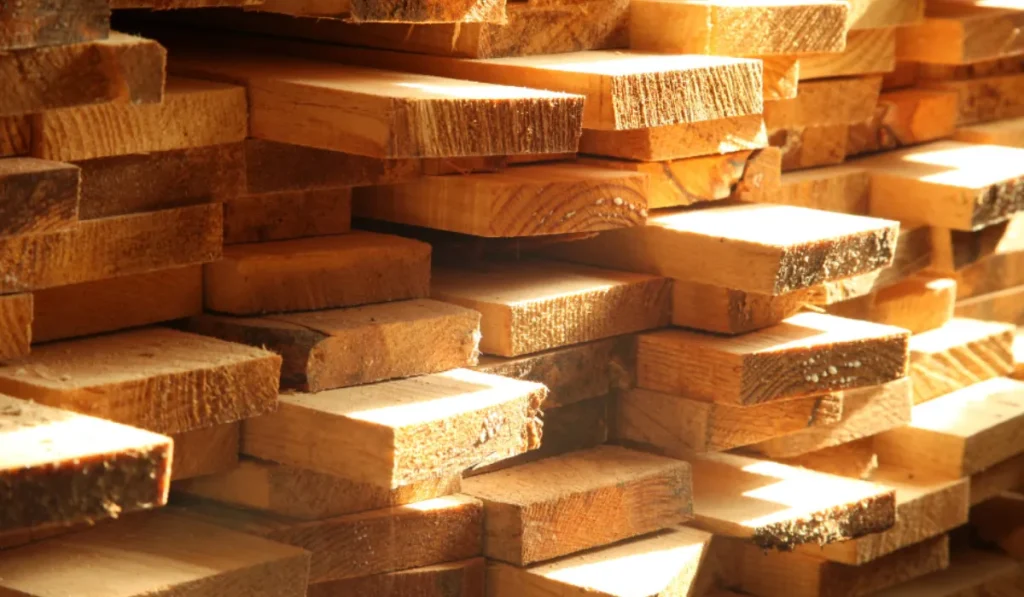A standard 2x4x8 piece of lumber weighs approximately 17 pounds. The weight can vary based on moisture content and wood species.
Determining the weight of a 2x4x8 is essential for construction projects, DIY endeavors, and when calculating load for transportation.
Lumber is a fundamental building material, and its dimensions and weight are crucial for structural integrity. Wood’s density plays a significant role, with some woods being heavier than others.
The 17-pound estimate corresponds to a dry, untreated piece of spruce, pine, or fir, commonly used in construction.
It’s pivotal to understand that wood’s weight can increase when wet, which is an important consideration for outdoor projects. Knowing the precise weight of lumber ensures safety and adherence to building codes during construction.
Keep in mind that specialty lumber or treated wood might deviate from the average weight, impacting overall project logistics and structure.

Composition And Characteristics Of 2x4x8 Lumber
The 2X4X8 lumber is a common piece of wood used in construction. Its name tells us about its size.
A “2X4” is 2 inches thick by 4 inches wide. The “8” represents the length in feet. The weight can vary because of different factors.
Wood Species And Density
Different trees mean different types of wood. Density is a key feature. It tells us how compact the material is. A denser wood has more mass per unit volume. This makes it heavier.
- Softwoods such as pine are lighter.
- Hardwoods like oak are heavier.
| Wood Species | Density (lbs/ft3) |
|---|---|
| Pine | 25-35 |
| Oak | 45-50 |
Moisture Content Impact On Weight
Moisture content changes weight. Wet wood weighs more than dry wood. Think of a sponge. A dry sponge is light. A wet sponge is heavy.
The weight of 2X4X8 lumber depends on the water inside. Lumber can have different moisture levels:
- Green lumber has much moisture.
- Kiln-dried lumber has less moisture.
Lumber’s moisture level affects its use. Green lumber is not good for indoor use before it dries. Dry lumber is stable and good for many projects.
Standard Measurements And Size

Understanding the standard measurements and size of a 2x4x8 piece of dimensional lumber is vital for anyone involved in construction or DIY projects.
Whether it’s for framing a wall, building a deck, or creating furniture, knowing the weight and dimensions ensures the right fit and support.
Dimensional Lumber Defined
Dimensional lumber is a term used for wood that has been pre-cut to standardized widths and depths.
Carpenters and builders commonly use these pieces in construction. The “2x4x8” refers to a board with an apparent width of 2 inches, a height of 4 inches, and a length of 8 feet.
Actual Vs. Nominal Sizes
It’s important to note the difference between actual and nominal sizes. Nominal dimensions are the names by which the lumber is sold and might not represent the true measurements of the wood.
| Nominal Size | Actual Size |
|---|---|
| 2×4 inches | 1.5×3.5 inches |
| 2×6 inches | 1.5×5.5 inches |
| 2×8 inches | 1.5×7.25 inches |
The actual dimensions are slightly less due to the drying and planing processes the wood undergoes. Always check the actual size before purchasing or starting a project.
Calculating The Weight Of Lumber

Understanding the weight of lumber can be crucial when planning projects. Whether for construction, transport, or design, estimating the mass of wood is key.
The weight of a 2x4x8 piece of lumber varies. It depends on the wood type and its moisture content. Let’s break down how to calculate this.
Weight Formula For Wood
To estimate lumber weight, use the formula: Weight = Volume x Density. First, find the volume by multiplying the length, width, and height of the wood.
Then, multiply this volume by the wood’s density. Remember that density varies by species and moisture content.
Weights are usually given in pounds per board foot. One board foot equals 144 cubic inches. Use a calculator for precise measurements!
Examples Using Different Wood Species
Different species of wood have different weights. Let’s look at examples using common wood types for a 2x4x8.
| Wood Species | Density (lbs/ft3) | Weight of 2x4x8 (lbs) |
|---|---|---|
| Pine | 25-35 | 13-17 |
| Douglas Fir | 33 | 17 |
| Oak | 47-55 | 24-28 |
To get these figures, multiply the volume of the 2x4x8 (5.33 ft3) by each wood’s density. Note that these are approximate.
Actual weight may slightly vary based on moisture content.
Practical Applications And Handling
Understanding the practical applications and handling of a 2x4x8 piece of lumber is essential. This knowledge makes projects easier.
Lumber this size is common in building frames for houses, making shelves and benches, and other structures. Knowing its weight helps in planning projects and ensuring safety.
Transporting And Working With 2x4x8 Lumber
A typical 2x4x8 foot lumber piece usually weighs around 17 pounds. The exact weight can vary based on the wood’s moisture content and type. For easy transportation, consider these tips:
- Use a vehicle that can safely carry the length and weight of the wood.
- Stack the wood flat to avoid warping during transport.
- Secure the load properly to prevent shifting and potential accidents.
While working with 2x4x8 lumber:
- Lift with your legs, not your back, to prevent injury.
- Wear gloves to protect your hands from splinters.
- Ask for help if the load is too heavy for one person.
Load-bearing Considerations
2x4x8 lumber is also popular for its load-bearing capabilities. Before selecting lumber for a project, consider these factors:
| Type of Wood | Weight it Can Support | Use Case |
|---|---|---|
| Pine | Up to 1,250 lbs | Framing |
| Spruce | Up to 1,300 lbs | Furniture |
| Douglas Fir | Up to 1,700 lbs | Outdoor Projects |
Remember to consider the wood’s grade and quality. These factors directly affect the lumber’s strength.
Always follow local building codes and consult with a professional when in doubt.
Factors That Influence The Weight Of Lumber
Understanding the weight of a 2x4x8 piece of lumber is not as straightforward as it appears.
It’s a moving target influenced by several factors beyond its dimensions. From the type of wood to its moisture content, different elements play a role.
Here’s a look at what can alter the scales.
Effects Of Treatment And Coatings
Preservatives and coatings add to the lumber’s weight. Treated wood, used for outdoor projects, carries heavy-duty chemicals.
These chemicals ward off insects and rot but can make the wood denser.
- Pressure-treated wood is often heavier compared to untreated wood.
- Paint or varnish layers also contribute to the overall weight.
Seasonal Variations In Wood Weight
Wood weight changes with the seasons. Lumber dries out more in summer and weighs less. In winter, it can absorb moisture, becoming heavier.
Regular fluctuations in temperature and humidity mean that the weight of a 2x4x8 is never constant.
| Season | Moisture Level | Typical Weight Change |
|---|---|---|
| Summer | Lower | Lighter |
| Winter | Higher | Heavier |
Remember, these weights vary and depend on specific conditions unique to your region or where the lumber was stored.
Importance Of Lumber Weight
Considering the weight of a 2x4x8 piece of lumber takes us far beyond just numbers on a scale. It influences how we handle materials, the cost of transportation, and even the sustainability of building practices.
Delving into the weight of lumber reveals a complex web of factors critical for professionals and DIY enthusiasts alike.
Implications For Construction Projects
Understanding the weight of lumber is essential in construction. Let’s break it down:
- Structural Integrity: Heavier wood could mean denser fibers, influencing strength.
- Workforce Efficiency: Lighter boards are easier to handle, speeding up work.
- Load Calculations: Accurate weight estimates ensure safety and compliance.
For example, an average 2x4x8 can weigh from 17 pounds (for softwoods) up to 24 pounds (for hardwoods). Knowing this helps determine how many pieces can safely be loaded onto a structure.
Weight’s Role In Sustainability And Shipping
Weight impacts sustainability and shipping. Here’s how:
- Lower Emissions: Lighter wood means fewer emissions during transport.
- Reduced Costs: Shipping costs drop with weight, saving money.
- Eco-friendly Choices: Opt for lighter, sustainably sourced wood.
| Lumber Type | Average Weight | Transport Emissions | Cost |
|---|---|---|---|
| Softwood 2x4x8 | 17 lbs | Lower | More Affordable |
| Hardwood 2x4x8 | 24 lbs | Higher | More Expensive |
Optimal selection and transportation strategies can result in noteworthy sustainability improvements.
Therefore, the weight of lumber extends significant influence on both ecology and economy.
FAQs About the Weight of 2X4X8 Lumber Piece
What Is The Weight Of A Standard 2x4x8?
The average weight of a kiln-dried, untreated 2X4X8 piece of lumber is about 13 pounds. This can vary slightly depending on the wood’s moisture content and species.
Does Wood Type Affect A 2x4x8’s Weight?
Yes, the weight of a 2X4X8 can vary depending on the wood species. For example, a 2X4X8 made from a denser wood like oak may weigh more than one from a lighter wood like pine.
How Does Moisture Impact 2x4x8 Lumber Weight?
Moisture content significantly impacts lumber weight. A green (not dried) 2X4X8 can weigh twice as much as its kiln-dried counterpart due to water content.
Can The Weight Of Pressure-treated 2x4x8 Differ?
Absolutely. A pressure-treated 2X4X8 can weigh more, typically around 17 pounds, due to the added weight of chemical preservatives.
Conclusion
Wrapping up our discussion on the weight of a standard 2x4x8 timber piece, we’ve delved into the factors influencing its mass.
Remember, the type of wood and moisture content are crucial. Whether you’re gearing up for a DIY project or professional construction, accurate knowledge of this common lumber’s weight is essential for safe handling and application.
With these insights, you’re now better equipped to tackle your woodworking endeavors with confidence.
Resources:
https://www.fs.usda.gov/research/treesearch/62200
https://portal.ct.gov/DEEP/Reduce-Reuse-Recycle/Proper-Use-and-Disposal-of-Treated-Lumber
